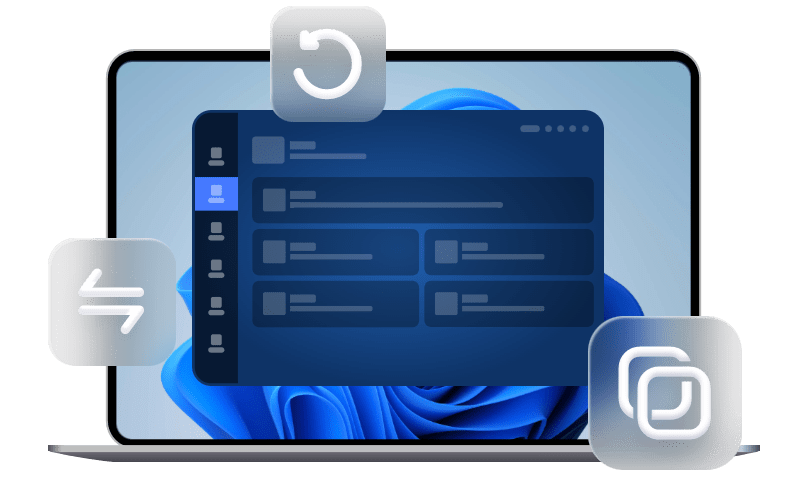How to Easily Backup Files with Best Free File Backup Software
Learn how to automatically backup files in Windows 11, 10, 8, 7 from this page. The best free backup software is used here.
What Files Should You Backup?
Here are some of the frequent backup objects listed, just for informational purposes only. Which files and folders to be backed up finally depends on your specific needs.
-
Documents: You should backup your documents which include your current work contents. Maybe also the temporary folders that are put on the desktop.
-
Music: If you don’t want yourself to be depressed by losing the costly MP3 downloads, you should backup them in advance.
-
Pictures and Videos: Family pictures and videos are priceless wealth, they are the witness of your life.
Best Free File Backup Software – AOMEI Backupper Standard
How to backup files to safeguard your data? You need the best free backup software – AOMEI Backupper Standard to make it. Then, let’s have a closer look at this software.
-
Multiple operating systems: You can use it to backup files in Windows 11/10/8.1/8/7.
-
Automatic file backup: You are allowed to backup files at daily/weekly/monthly followed by a specific time and don’t need to worry about data loss because of forgetting to backup your important files.
-
Full/incremental/differential backup: You can choose to create an exact copy of all your files or backup only changes with different backup types. It’s all your decision. (Differential Backup is a paid feature.)
-
Various backup locations: You could use internal hard drive, external hard drive, USB flash drive, network drive, cloud storage, network share or NAS to backup files.
In addition, you are allowed to backup system, disk and partition with this software.
How to Backup File to External Drive
As the best free file backup software, AOMEI Backupper Standard can help you backup files in a simple and efficient way. The entire process can be completed within 5 steps. You just need to download and install this software on your computer. Then prepare an external hard drive to store your files.
Here are the detailed operating steps to perform free files backup in Windows 10. These steps are also applied to Windows 11/8.1/8/7.
Step 1. Launch AOMEI Backupper Standard, you will see its deep-blue interface. Then, click File Backup under the Backup tab.
Step 2. Click Select Source > Add File or Add Folder according to your needs. Choose the files or folders that you want to backup.
Step 3. Click the destination box to select backup destination. You can backup files to external hard drive, NAS network location, or other locations as long as it can be detected by Windows.
Step 4. Click Schedule to automate the file backup task. You can schedule backup with one time, daily, weekly, monthly, or event triggers mode, etc.
There are two more options at the lower location, namely, Options, and Backup Scheme, which can help you customize the file backup task.
>> Options: You can comment, enable email notification, set compression level, create pre/post-command, etc.
>> Backup Scheme: 4 different backup schemes are supported and you can use them to delete old backups to free up disk space while keeping the latest backup versions. But they are available on AOMEI Backupper Professional at least.
Step 5. Confirm everything is OK and click Start Backup to backup files.
- You are not advised to backup your files to system partition where the operating system is installed on.
- You are allowed to backup computer in Windows 10 with “System Backup” or “Disk Backup” feature.
- If you want to backup files without booting Windows, you need to create a bootable media in advance.
- It’s suggested to create 3 copies of your files, save them to 2 different locations, and keep one off-site backup. It’s the best way to backup files according to the 3-2-1 backup strategy.
- All the successful tasks will be listed under the Home tab, and you can manage the backup task by selecting a specific task and corresponding options. For example, if you want to change a manual task to an automatic one, select the file backup task and then the Schedule option.
Further reading
What Is File Backup?
System Backup, Disk Backup and Partition Backup are considered to be useful and effective ways to protect computer as well as data on it. But they will backup all files whether you want or not. Meanwhile, they still have deficiencies in storage space and processing time. Therefore, there is a file backup.
File Backup refers to backing up specified files or folders to an image file to prevent data loss while using less backup space and time. And you can only see the backed up files by decrypting them at first. For instance, you can choose to create backups for your family pictures, favorite music or other vital files rather than backup all of them.
In addition, file backup has three backup types, including full backup, incremental backup and differential backup. The latter two backups are based on full backup and only backup changes of files, which will save much disk space and backup time.
Why Need File Backup?
It’s obvious that no one would enjoy the tedious process of taking backup, but the pain of losing precious family pictures, sensitive files and favorite music still can be very annoying. You could not afford to lose those valuable files because most of them are irreplaceable.
Data stored on your computer can be very fragile and vulnerable to attack due to system crash, software conflict, virus attack (ie: ransomware attack in 2017) or human errors. And it’s probably gone forever.
Therefore, it’s essential to backup files in Windows 11/10/8/7 regularly just in case or to hire double insurance for your important files, preferably a scheduled backup. Then, when something bad happens, you can restore files from backup without any obstacle.


